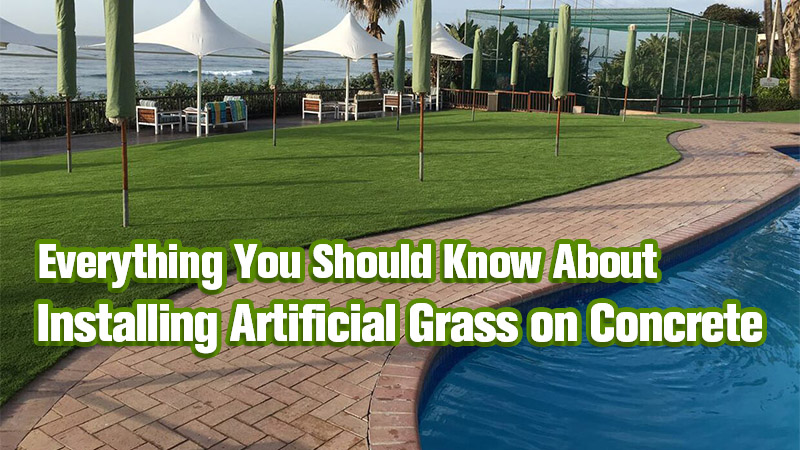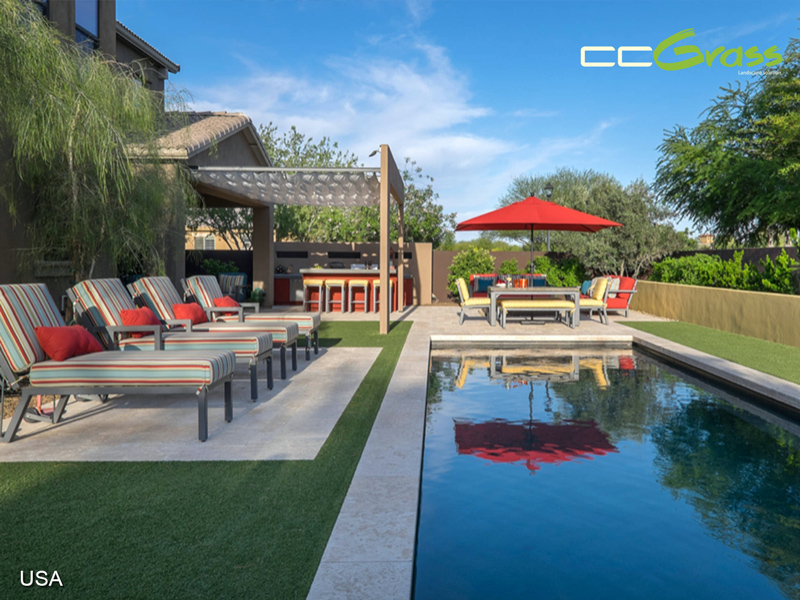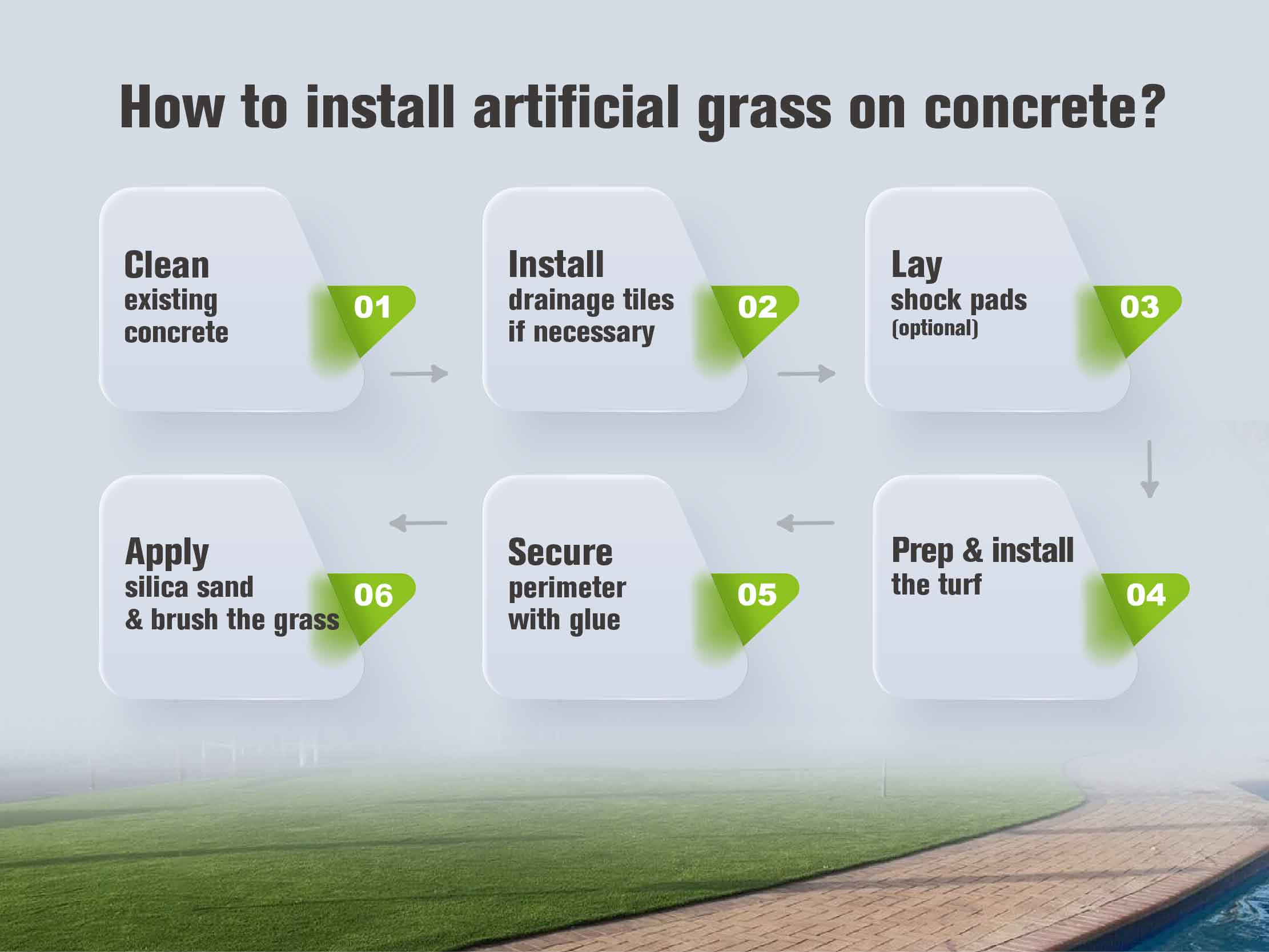Everything You Should Know About Installing Artificial Grass on Concrete
- 11/14/2023
Embarking on the journey to bring a touch of vibrant green to your concrete surroundings? This guide explores installing artificial grass on concrete—transforming lifeless spaces into lively retreats. From feasibility to benefits and a step-by-step roadmap, it’s your go-to resource for creating nature-inspired havens.

In this article:
Can fake grass be installed on concrete or asphalt?
In brief, the answer is a definite yes—fake grass can indeed be installed on top of asphalt or concrete surfaces. Surprisingly, in certain aspects, this process is simpler than installing it on a traditional foundation, as it eliminates the need for multiple layers of preparation before laying the turf.
However, while it is feasible, it doesn’t necessarily imply it’s the optimal choice. Before you embark on covering an unwanted concrete surface with synthetic turf, consider the following:
Surface must be smooth and even
If the concrete surface where you plan to lay artificial grass has any irregularities or undulations, they will become apparent. Therefore, it’s advisable to avoid placing synthetic turf on cracked or damaged areas.
To ensure the concrete surface is suitable for installing artificial grass, address cracks and flaws by filling them before proceeding.
Adequate drainage
Artificial turf boasts excellent drainage properties, eliminating the need for additional drainage systems. Check the concrete’s drainage by soaking it with a hose. Any pooling of water indicates drainage issues, which could lead to mold formation. Indoor turf generally doesn’t require drainage.
Insufficient cushioning
When artificial grass is laid over concrete surfaces, it lacks the cushiony feel of real grass. While this might not be an issue for purely decorative lawns, it’s a crucial consideration if you anticipate children, pets, or physical activities on the turf.
To address this, adding shock pads beneath the artificial lawn significantly mitigates the concrete’s hardness, enhancing overall comfort and safety.

Benefits of installing artificial grass on concrete
Boost overall appearance and functionality
Adding artificial turf to concrete doesn’t just make the area look better—it also boosts functionality. For instance, a concrete pool deck becomes safer and more inviting with the addition of synthetic grass. Likewise, transforming a concrete play area with soft artificial grass creates a secure and enjoyable space for both children and pets.
Adaptable to any shape or style
Artificial turf offers boundless design possibilities, effortlessly adapting to any shape or style you envision. Whether it’s a classic square or a more intricate pattern—circles, ovals, triangles, or diamonds—synthetic turf can be cut to fit, allowing for the creation of unique and personalized outdoor or indoor living spaces.
Temperature regulation in hot summer conditions
Concrete surfaces can become uncomfortably hot, especially in warmer climates. Artificial grass, with its to some extent insulation properties, assists in regulate surface temperatures. This not only fosters a more comfortable environment but also helps keep the surface relatively cooler during hot summer conditions.
Elevating spaces with artificial turf on concrete surfaces
Artificial turf offers a flexible solution for enhancing both residential and commercial spaces. It finds application in diverse settings such as driveways, patios, balconies, and around pool areas.
Whether you seek to elevate the curb appeal of an entrance, fashion a comfortable patio, or infuse a touch of greenery into a compact balcony, synthetic turf proves adaptable for the transformation of concrete spaces.
Moreover, businesses like restaurants and retail outlets can employ fake grass to craft inviting outdoor environments, thereby enriching the overall customer experience.
How to install artificial grass on concrete? Step-by-step guide

Step 1: Clean existing concrete
Begin by thoroughly cleaning the concrete surface of any debris, chemicals, dirt, mold, or residue. You can hose down the concrete and scrub it with a stiff broom.
Allow the surface to dry, ensuring that any chemicals from cleaning agents completely dissipate before moving on to the next step.
Step 2: Install drainage tiles if necessary
Cleaning the concrete or pavement is also an excellent opportunity to evaluate its drainage capabilities. If water dissipates without forming puddles, you can proceed to the next step. If not, consider installing drainage tiles between the concrete and the artificial grass to improve drainage and air circulation.
Standing water may lead to mold issues beneath the grass, affecting the backing. It could also result in large puddles on the grass, rendering it unusable until the water drains or is removed.
Step 3: Lay shock pads (optional)
While synthetic grass can be placed directly on concrete, some prefer an additional cushion of padding. Artificial turf provides traction and some cushioning for walking, but for those seeking heightened comfort, think about incorporating shock pads.
This choice impacts cost, installation time, and the final look—it’s a personal preference, not a necessity.
Step 4: Prep & install the turf
Unroll the artificial grass and let it sit in sunlight for at least an hour to smooth out creases. Cut it to the desired dimensions, trimming edges from the back to avoid cutting through the stitches.
If there are seams, ensure the fibers face the same direction. Trim 3 stitches on each side to ensure a seamless joint. Place tape along the underside of the seam, applying pressure to bond them securely.
Step 5: Secure the perimeter with glue
Trim excess turf along the concrete edge using a utility knife. Fold back the grass edges, applying glue around the entire perimeter. Allow a few hours for proper bonding; avoid walking on the grass during this time to prevent any shifting.
Step 6: Apply silica sand & brush the grass
After the glue dries, move on to the final step. Applying silica sand infill offers a range of benefits, including stabilizing the turf to prevent wrinkles, boosting durability, and maintaining the fibers in an upright position for a more appealing look. Evenly distribute the infill and then use a rake or grass brush to groom the lawn.
Conclusion
We trust this article has provided valuable insights into installing artificial grass on concrete. For our esteemed partners and dealers, we offer extensive market support materials to enhance your market penetration.
At CCGrass, we offer comprehensive turf solutions catering to diverse needs such as sports, landscaping, commercial spaces, putting greens, and pet-friendly areas. Eager to explore more about our products and services or do have specific questions? Connect with us today at 86 25 6981 1666 or via email at [email protected].



